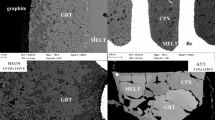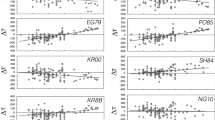Abstract
Many of the “S-type” granitoid plutons that comprise Hepburn and Wentzel Batholiths of the Early Proterozoic Wopmay Orogen contain garnet, biotite and rarely cordierite and sillimanite. The garnet, cordierite and sillimanite are interpreted to be relict crystals brought up from the depth of origin of the magmas.
Two methods of geothermobarometry were applied to ten samples from the two batholiths: the garnet-biotite Fe-Mg exchange equilibrium (Ferry and Spear 1978) and the garnet-plagioclase-sillimanite-quartz equilibrium (Ghent 1976). The intersection of the two displaced equilibrium curves on a P-T plot provides an estimate of theP-T conditions of equilibration of the minerals.
P-T estimates in eight of ten samples ranged between 800 and 1,100°C, and 5 and l0 kbars. These values are in distinct contrast to the typical 650 °C — 3 kb results obtained from the immediately adjacent metapelites, to which the same geothermobarometers were applied.
Numerous theoretical and practical problems are encountered both in the application of the methods and in the interpretation of the results. Two of the important theoretical problems are (1) how the anatexis of certain minerals in the equilibria influences the elemental ratios of other minerals that remain as solids, and (2) how far the elemental ratios of the minerals re-equilibrated below the maximalP-T conditions. The most serious practical problem was chloritization of biotite, which generated spuriously high temperatures on the garnet-biotite geobarometer.
The significant difference in results between the batholith rocks and the metamorphic rocks indicates that the minerals did not re-equilibrate to sub-magmatic conditions. Using theP-T results as a guide to the conditions of origin of the plutons, it appears that several of the plutons were generated at depths between 21 and 29 km, and rose between 8 and 18 km to the level of emplacement.
The core-to-rim zonation of the garnets produces aP-T trend that is towards lower pressure, temperature or both. Such a pattern would be expected in a pluton that rose to the less extreme conditions at higher levels in the crust.
The geothermobarometers successfully distinguish between granitoid rocks that were generated at depth and those that were formed by anatexis of country rocks near the level of emplacement.
Similar content being viewed by others
References
Andersen DE, Olimpio JCL (1977) Progressive homogenization of metamorphic garnets, South Morar, Scotland: evidence for volume diffusion. Can Mineral 15:205–216
Brown GC, Fyfe WS (1970) The production of granitic melts during ultra-metamorphism. Contrib Mineral Petrol 28:310–318
Chappell BW, White AJR (1974) Two. contrasting granite types. Pacif Geol 8:173–174
Easton RM (1980) Stratigraphy and geochemistry of the Akaitcho Group: a pre-orogenic rift succession in north-central Wompay Orogen (Early Proterozoic), Hepburn Lake map area (86J), District of MacKenzie. In: Current research, Part A. Geol Surv Can Pap 80-1A
Ferry JM, Spear FS (1978) Experimental calibration of the partitioning of Fe and Mg between biotite and garnet. Contrib Mineral Petrol 66:113–117
Fyfe WS (1973) The generation of batholiths. In: Experimental petrology and global tectonics. Tectonophysics 17:273–283
Ghent ED (1976) Plagioclase-garnet-Al2SiO5-Quartz: a potential geothermometer-geobarometer. Am Mineral 61:710–714
Ghent ED, Robbins DB, Stout MZ (1979) Geothermometry, geobarometry, and fluid compositions of metamorphosed calc-silicates and pelites, Mica Creek, British Columbia. Am Mineral 64:874–885
Green TH (1976) Experimental generation of cordierite-or garnetbearing granitic liquids from a pelitic composition. Geology 4:85–88
Hine R, Williams IS, Chappell BW, White AJR (1978) Contrasts between I- and S-type granitoids of the Kosciusko Batholith. J Geol Soc Austral 25:219–234
Hoffman PF (1980) Wopmay Orogen: A Wilson cycle of Early Proterozoic age in the northwest of the Canadian Shield. In: Strangway DW (ed) The continental crust and its mineral deposits. Geol Ass Can Spec Pap 20
Hoffman PF, St-Onge MR, Carmichael DM, de Bie I (1978) Geology of the Coronation geosyncline (Aphebian), Hepburn Lake sheet (86J), Bear Province, District of Mackenzie. In: Current research, Part A. Geol Surv Can Pap 78-1A:147–151
Hoffman PF, St-Onge MR, Easton RM, Grotzinger J, Schulze DE (1980) Syntectonic pluxonism in north-central Wopmay ogen (early Proterozoic), Hepburn Lake Map Area, District of MacKenzie. In: Current Research, Part A. Geol Surv Can Pap 80-1A:171–177
Holdoway MJ (1971) Stability of andalusite and the aluminumsilicate phase diagram. Am J Sci 271:97–131
McGlynn JC (1970) Bear Province. In: Douglas RJS (ed) Geology and economic minerals of Canada. Geol Surv Can Economic Geology Report 1:77–84
Munoz JL, Ludington SD (1974) Fluorine-hydroxyl exchange in biotite. Am J Sci 274:396–413
Robertson JK, Wyllie PJ (1971) Rock-water systems with special reference to the water-deficient regions. Am J Sci 271:252–277
Schairer JF, Bowen NL (1955) The system K2O-Al2O3-SiO2. Am J Sci 253:681–756
Schairer JF, Bowen NL (1956) The system Na2O-Al2O3-SiO3. Am J Sci 254:129–195
Stephenson NCN (1978) Co-existing garnets and biotites from Precambrian gneisses of the south coast of Western Australia. Lithos 12:73–87
Streckheisen AL (1967) Classification and nomenclature of igneous rocks. Neues Jahrb Mineral Abh 107:144–214
St-Onge MR (1981) “Normal” and “Inverted” metamorphic isograds and their relation to syn-tectonic Proterozoic batholiths in the Wopmay Orogen, Northwest Territories, Canada. Tectonophysics 76:295–316
St-Onge MR (1982) Geothermometry and geobarometry in pelitic schists and gneisses of the Early Proterozoic Wopmay Orogen, Northwest Territories, Canada (in press)
Thompson AB (1976) Mineral reactions in pelitic rocks: II. Calculation of someP-T-X (Fe-Mg) phase relations. Am J Sci 276:425–454
Tracy RJ, Robinson P (1976) Garnet composition and zoning in the determination of temperature and pressure of metamor-phism, Central Massachusetts. Am Mineral 61:762–775
Watson JV (1978) Precambrian thermal regimes. Philos Trans R Soc London A278:431–440
White AJR, Chappell BW (1977) Ultra-metamorphism and granitoid genesis. In: Experimental petrology related to extreme metamorphism. Tectonophysics 43:7–22
Winkler HGF (1979) Petrogenesis of metamorphic rocks. 5th ed, Springer-Verlag, New York, 348 pp
Author information
Authors and Affiliations
Rights and permissions
About this article
Cite this article
Pattison, D.R.M., Carmichael, D.M. & St -Onge, M.R. Geothermometry and geobarometry applied to early proterozoic “S-type” granitoid plutons, Wopmay Orogen, Northwest Territories, Canada. Contr. Mineral. and Petrol. 79, 394–404 (1982). https://doi.org/10.1007/BF01132069
Accepted:
Issue Date:
DOI: https://doi.org/10.1007/BF01132069




